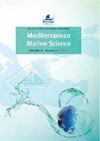直布罗陀海峡初秋浮游生物组合的变异:分区分析
IF 2.3
3区 环境科学与生态学
Q1 MARINE & FRESHWATER BIOLOGY
引用次数: 0
摘要
直布罗陀海峡(SG)是地中海与全球环流的唯一连接。由于其流体动力学的复杂性,包括强烈的潮汐强迫和明显的空间梯度和锋面,SG是探索中上层生物群落物理-生物耦合的杰出海洋区域。作者揭示了两周潮汐尺度(春潮和小潮)和局部过程(上升流和潮汐地形混合)在海峡浮游生物组合中的作用。为此,我们在2008年初秋进行了一次海洋考察,采集了高分辨率网格采样和春季/小潮期潮汐情况。浮游生物特征是通过不同的浮游生物自动和半自动分析技术(流式细胞术、FlowCAM、LOPC和Ecotaxa)捕获的,这些技术允许覆盖从微浮游生物到中浮游生物的广泛规模的群落。根据生物地球化学和主要水柱性质,将SG划分为两个簇。集群1 (CL1)覆盖了特拉法加角(CT)周围的浅层生产区域。CL1中叶绿素和营养物质浓度较高,浮游植物以聚藻球菌和海岸硅藻为主,浮游动物中浮游生物比例最高(31%)。聚类2 (CL2)覆盖开阔海域,呈现出更多的低营养特征,即低氮水体,叶绿素浓度较低,微浮游生物群落以原绿球藻为主,中浮游动物以全浮游生物为主。在初秋的条件下,整体营养枯竭和分层的水域,CT区域成为一个生态系统,在这里,不断的潮汐混合和营养供应与活跃的生产相结合,也受到高停留时间的青睐,最终形成了该地区独特的浮游生物群落。本文章由计算机程序翻译,如有差异,请以英文原文为准。
Variability of early autumn planktonic assemblages in the strait of Gibraltar: a regionalization analysis
The Strait of Gibraltar (SG) is the only connection of the Mediterranean Sea with the global circulation. The SG is an outstanding marine region to explore physical-biological coupling of pelagic communities due to its hydrodynamic complexity, including strong tidal forcing and marked spatial gradients and fronts. The authors have unravelled the role of the fortnightly tidal scale (spring and neap tides) and local processes (upwelling and tidal-topographic mixing) that shape planktonic assemblages in the Strait. To do so, an oceanographic cruise was taken in early autumn 2008 with a high-resolution grid sampling and spring/neap tidal conditions. The planktonic features were captured using different automatic and semi-automatic techniques of plankton analyses (flow cytometry, FlowCAM, LOPC and Ecotaxa) that allowed covering a wide range of sizes of the community from pico- to mesoplankton. The SG was sectorized into two clusters based on the biogeochemical and main water column properties. Cluster 1 (CL1) covered shallow productive areas around Cape Trafalgar (CT). CL1 presented higher concentrations of chlorophyll and nutrients, and phytoplankton was mostly represented by Synechococcus and coastal diatoms while zooplankton had the highest percentage of meroplankton (31%). In contrast, cluster 2 (CL2) covered open ocean waters and presented more oligotrophic features, i.e. nitrogen-depleted waters with lower chlorophyll concentrations and a picoplankton community dominated by Prochlorococcus and holoplankton predominance in mesozooplankton. Under early autumn conditions with overall nutrient-depleted and stratified waters, the CT area emerges as an ecosystem where the constant tidal mixing and nutrients supply is coupled with an active production also being favored by high residence times and finally shaping a plankton community with unique features in the area.
求助全文
通过发布文献求助,成功后即可免费获取论文全文。
去求助
来源期刊

Mediterranean Marine Science
MARINE & FRESHWATER BIOLOGY-
CiteScore
5.20
自引率
17.90%
发文量
34
审稿时长
>12 weeks
期刊介绍:
The journal Mediterranean Marine Science (MMS), published by the Hellenic Centre for Marine Research (HCMR), issues three volumes annually. The journal welcomes original research articles, short communications, New Mediterranean Biodiversity records, extended reviews, comments, and Theme sections in all fields of Oceanography, Marine Biology, Marine Conservation, Fisheries and Aquaculture in the Mediterranean area and the adjacent regions. All content is peer reviewed.
 求助内容:
求助内容: 应助结果提醒方式:
应助结果提醒方式:


